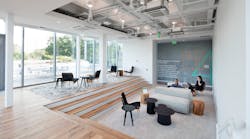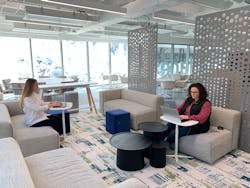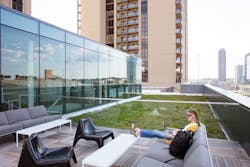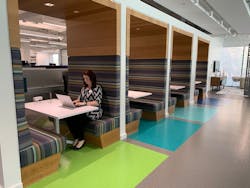By Darby Gracey
Work-from-home changed the workforce as we know it. From adopting virtual meetings to the craze of on-screen exercise classes, we collectively gained access to more choice and flexibility within our workday. Today, it’s become an expectation for most employees, and now, office spaces must reflect that freedom that employees came to love.
Office design today should support in-person collaboration and create a unique sense of belonging in your team so that they want to come into the workplace. Updating your space in response to this will help you retain and grow your current talent to fit the needs of your business.
At Home at Work
This doesn’t have to be a significant financial commitment. In fact, you can start by reconfiguring current furniture to establish zones for specific kinds of work and support various working styles. An example at Interface was repurposing a pre-COVID Executive Conference Room into a hackable space for creative collaboration and ideation. The space is now highly flexible with configurable furniture that can be adapted in endless ways to make in-person meetings more effective.
Benefits of Biophilic Design
Invest in Technology, Question Policies
It’s important to note that your company will be more successful if you pair these design updates with technological investments as well. This might mean adopting a desk reservation system that allows employees to select where they will sit when they come in based on where team members are sitting or on their own needs for the day. This not only provides further collaboration but provides the freedom and flexibility of choosing different environments within the office.
Another example that has become especially helpful for hybrid workers is having portable charging stations for laptops and other electronic devices–we have a lot to remember to pack on any given day and eliminating stress about forgetting a charging device is an easy step companies can take to support employees.
The last step here is to look at your in-office policies and protocols and ask yourself: do these still support our team today? While the consensus may be yes, there are certain tweaks that can be made in response to what your people want, like a more relaxed dress code. A survey found that 10% of employees would take a pay cut over having to get dressed for work every day–that says a lot about the importance of easing the transition into the office and implementing one of the perks we experiences working from home.
It’s clear that no one has all the answers when it comes to what the workplace should look like, but a good place to start is with your people. Find out what their needs are and what would make the return to the office more comfortable for them. By starting here, at the core of who your company is, you can begin to identify a way-forward that aligns with your culture, budget, and vision.
About the author: As Interface’s Global Director of Worklife and Workplace Strategy, Darby Gracey serves as a champion for Interface’s organizational culture, helping to embed our values, inspire commitment to the Interface mission, and deliver a positive employee experience. She also works to provide and maintain healthy, functional, innovative, and collaborative environments for the wellbeing of employees and customers in all Interface work locations globally. Darby’s responsibilities include overseeing our global headquarters, known as Base Camp, and she has played an integral role in reimagining the Midtown Atlanta space to be a high-design, post-pandemic office of the future.





